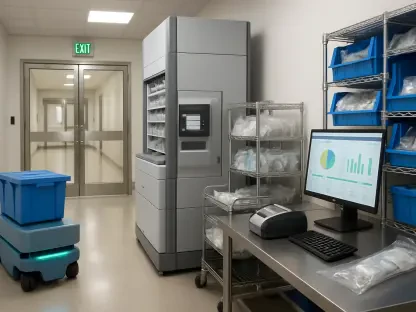In the heart of Massachusetts, the city of Chicopee finds itself grappling with a challenge that resonates across the nation: the relentless rise in health insurance costs, which burden both municipal budgets and residents. During a recent special City Council meeting held in a crowded City Hall auditorium, local leaders and residents came together to confront this pressing issue. The discussion, spearheaded by Mayor John Vieau and supported by experts from HUB International, aimed to shed light on the city’s escalating healthcare expenses and explore sustainable solutions. With city union workers and members of UFCW Local 1459 voicing concerns through protests for more affordable coverage, the urgency of the situation was palpable. This gathering underscored a critical financial burden that impacts not only municipal budgets but also the livelihoods of employees and families. As costs continue to climb, Chicopee’s approach offers a glimpse into how local governments can navigate these turbulent waters with innovative strategies and a commitment to transparency.
Addressing the Financial Strain of Healthcare Expenses
The financial weight of health insurance costs has become a defining factor in Chicopee’s fiscal planning, particularly evident in the budget for the upcoming fiscal year. A staggering $3.4 million increase in the Human Resources budget has been largely attributed to these rising expenses, highlighting the scale of the challenge. Mayor Vieau has been vocal about the shared responsibility between the city and its employees, working to dispel myths that the burden falls solely on one side. This open dialogue during the City Council meeting sought to clarify the complexities of funding healthcare while ensuring that essential services remain intact. The numbers paint a stark picture of the pressures local governments face as they strive to balance fiscal responsibility with the need to provide adequate benefits. Beyond just numbers, this situation reflects a broader struggle to maintain affordability in an era where healthcare costs outpace inflation, pushing municipalities to rethink traditional approaches to employee benefits.
Moreover, the city has undergone a significant transformation in its health insurance model over recent years, shifting from a fully insured plan to a partial self-insurance framework. This change, detailed by HUB International representatives during the meeting, involved adjusting deductibles significantly, moving from a modest $500 to a much higher $5,000. Employees cover the initial portion, while the city supports the remainder through a dedicated health plan trust, which currently holds approximately $2.5 million in reserves. This trust, co-owned by the city and plan participants, serves as a buffer against unexpected spikes in costs. Such a strategic pivot aims to give Chicopee greater control over expenditures by directly managing a large portion of healthcare payments. This model stands in contrast to fully insured plans where costs can be less predictable, showcasing a proactive effort to stabilize finances in the face of industry-wide challenges.
Innovating with New Health Plan Options
Chicopee has taken a bold step forward by introducing the Diversified Group Brokerage (DGB/ClaimDoc) plan, a unique offering that sets it apart from other Massachusetts municipalities. Unlike many plans that face annual rate hikes, this option boasts a remarkable 0% rate increase compared to the previous fiscal year, providing much-needed relief to participants. The plan’s appeal is evident in its enrollment surge, with a 66% increase in the current fiscal year, bringing in 197 new employees for a total of 390 members. HUB International’s team highlighted that under this near-full self-insurance model, about 90% of healthcare costs are paid directly to providers, enhancing cost efficiency. This innovative approach not only offers an alternative to traditional plans but also ensures existing options remain available, catering to diverse employee needs. Such adaptability demonstrates how localized solutions can address widespread financial pressures in healthcare.
Additionally, the city’s efforts to curb costs through this new plan reflect a deeper understanding of employee priorities and fiscal constraints. The significant uptake of the DGB/ClaimDoc plan suggests that workers are receptive to alternatives that promise stability in premiums, even as deductibles have risen over time. Compared to other municipalities and even the state’s Group Insurance Commission, which recently reported substantial losses, Chicopee’s most enrolled plans offer rates lower than 90% of comparable options. This positioning indicates a relative advantage, achieved through deliberate policy choices and partnerships with knowledgeable consultants. By prioritizing direct cost management and innovative offerings, the city is crafting a blueprint that could inspire others facing similar dilemmas, proving that creativity in plan design can yield tangible benefits for both administration and staff.
Navigating Broader Industry Challenges
Beyond local efforts, Chicopee’s struggle with health insurance costs is emblematic of larger trends affecting municipalities and private sectors alike. An aging population, rising prevalence of chronic diseases, and skyrocketing prescription drug prices contribute to an environment where expenses are increasingly difficult to contain. Additionally, the lingering impact of delayed medical care during the COVID-19 pandemic—often termed the “COVID hangover”—has led to a surge in demand for services, further driving up costs. These systemic issues create a complex landscape where no single solution can address all facets of the problem. During the City Council meeting, it became clear that while Chicopee is taking proactive steps, the root causes of cost escalation are deeply entrenched in national healthcare dynamics, requiring a multifaceted response that extends beyond municipal borders.
Furthermore, the tension between cost-saving measures and employee expectations remains a critical point of discussion in Chicopee. Public protests by union workers prior to the meeting underscored a demand for lower premiums, reflecting a broader sentiment that affordability must be prioritized. Despite these challenges, the city’s leadership, alongside HUB International, has committed to balancing employee needs with fiscal sustainability. This delicate equilibrium is evident in the transparency of the recent meeting, where detailed presentations aimed to bridge understanding between policymakers and the public. While systemic pressures like soaring service costs persist, Chicopee’s comparative success in maintaining lower rates than many peers suggests that targeted innovations can mitigate some of the broader industry burdens, offering a model of resilience amid widespread healthcare cost crises.
Reflecting on Strategic Responses and Future Pathways
Looking back, Chicopee’s response to escalating health insurance costs stands as a testament to strategic adaptation and transparent governance. The special City Council meeting provided a platform for dissecting the financial challenges and showcasing the shift to partial self-insurance, which has been carefully implemented to manage expenditures. The introduction of the DGB/ClaimDoc plan marked a pioneering effort that not only stabilized rates for many but also saw significant employee enrollment, reflecting trust in the city’s direction. These steps, coupled with a health plan trust that bolsters financial security, position Chicopee as a leader among Massachusetts municipalities in addressing healthcare affordability.
Moving forward, the focus should pivot to sustaining these innovations while exploring additional avenues for cost containment. Collaborating with healthcare providers to negotiate better rates, investing in preventive care programs to reduce long-term expenses, and continuously engaging with employees to understand their evolving needs could enhance current efforts. As systemic challenges like rising drug prices remain, Chicopee might also consider advocating for broader policy changes at the state or national level to tackle root causes. By building on past successes and remaining agile in the face of industry shifts, the city can continue to serve as an example of how localized action can navigate the daunting landscape of healthcare costs.









